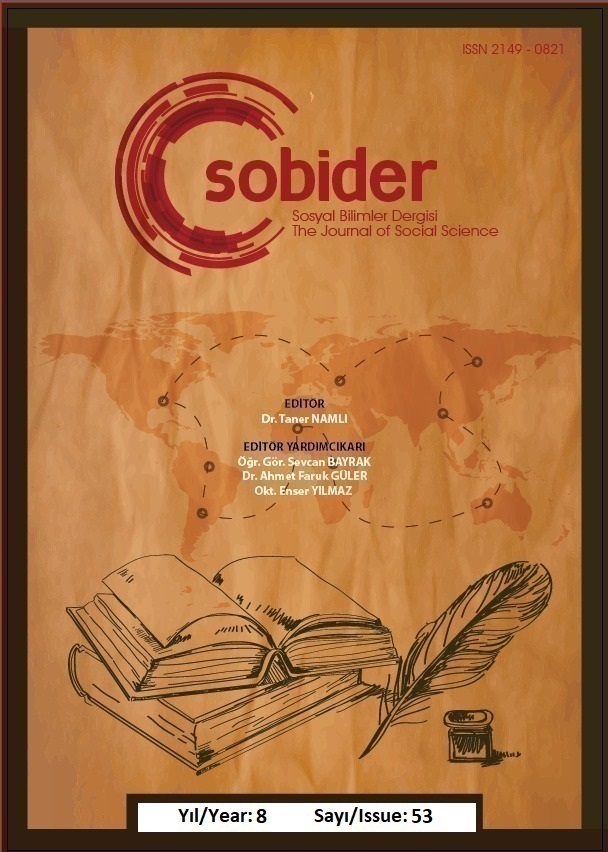Author :
Abstract
Bu çalışma, kanat imgesinin heykel sanatı tarihinde içerik olarak hangi anlamları karşıladığını ve biçimsel olarak geçirdiği değişiklikleri içermektedir. Bu nedenle öncelikle kanat imgesiyle sembolize edilen kavramlar açıklanmış ve bu kavramların kanat formuyla aktarıldığı kabartma ve heykel örnekleri Modernizm öncesi ve sonrası olarak iki bölümde aktarılmıştır. ‘Modernizm Öncesi Dönemde Kanat İmgesinin Sembolik Anlamları ve Heykelde Kullanımı’ adlı ikinci bölümde, geçmiş uygarlıklarda kanat imgesinin taşıdığı anlamlar, seçilmiş heykel ve kabartmalar üzerinden örneklendirilmiştir. Üçüncü bölümde kanat imgesinin modern heykelde nasıl ele alındığı; biçim, malzeme ve anlamdaki dönüşümler yabancı ve Türk sanatçıların eserleri üzerinden incelenmiştir. Çalışmada seçilen örnekler kanat imgesinin tarihsel, biçimsel ve anlam bakımından aldığı çeşitliliği yansıtacak şekilde seçilmiştir.
Keywords
Abstract
This work involves meanings to which wing image corresponds and formal changes of wing image in history of sculpture. To begin with, concepts symbolised with wing image are explained and examples of reliefs and sculptures of these concepts narrated by wing form are described in two chapters respectively pre-modern and post-modern. In the second chapter "Symbolic Meanings and the Usage of Wing Image in Sculpture in Pre-modern Era" meanings carried by wing image in past civilizations are examplified with selected sculptures and reliefs. In the third chapter, how wing image is adopted in modern sculpture in the context of form, material and, transformation of its meaning is analysed by artworks of international and Turkish artists. The works selected in the research were chosen to reflect the diversity of the wing image in terms of historical, stylistic and meaning.
Keywords
- Khazâie, M. (2005). “The Source and Religious Symbolism of the Arabesque in Medieval Islamic Art of Persia.” Central Asiatic Journal. Vol. 49. No. 1. s.27-50
- Martin, T. (2001). “The Development of Winged Angels in Early Christian Art.” Espacio, Tiempo y Forma, SerieVII, Historia del Arte. No:14. s. 11-29
- Michaux-Colombot, D. (2008). “The Royal Hittite Title ‘My Sun’ and the Winged Sun Disk.” In: 38. ICANAS, Religion, vol. 1, International Congress of Asian and North African Studies, Ankara 2007, Atatürk Kultür, Dil Ve Tarih Yüsek Kuramu Yaninlari 3/1, Ed. Zeki Dilek et al., Ankara, s. 329-353.
- Nicholson, P.J. (2018). “Antony Gormley, Angel of North, 1998.” Occupational Medicine, Volume 68, Issue 6, August 2018, Pages 352–353,
- Sadıkoğlu P. (2006). “Antik Mısırın Günümüz Sanatına Uzantıları ve Bir Yeniden Yorumlama.” (Yüksek Lisans Tezi) Yedi Tepe Üniversitesi. İstanbul.
- Selz, P. (1959). “New Images of Man.” The Museum of Modern Art. New York.
- Suna H. (2007). “Ege Mitolojisinin 20. Yüzyıl Heykel Sanatına Etkisi.” (Yüksek Lisans Tezi) Marmara Üniversitesi. İstanbul.
- Watts, E.W., Girsh B. (1998). “The Art of Ancient Egypt: A Resource for Educators.” The Metropolitan Museum of Art,
- http1: https://library.acropolis.org/the-symbolism-of-wings/ (Erişim tarihi: 11.09.2019)
- http2: https://en.wikipedia.org/wiki/Griffin (Erişim tarihi:12.09.2019)
- http3: https://www.louvre.fr/en/oeuvre-notices/winged-victory-samothrace (Erişim tarihi: 28. 09.2019)
- http4: https://www.ancient.eu/Hermes/(Erişim Tarihi: 03.10.2019)
- http5: https://www.michelangelo.org/angel.jsp (Erişim tarihi: 06.07.2021)
- http6: https://kimbellart.org/collection/ap-198702-ab (Erişim tarihi: 06.07.2021)
- http7: http://www.musee-rodin.fr/en/collections/sculptures/call-arms (Erişim tarihi: 07.10.2019)
- http8: https://www.moma.org/documents/moma_catalogue_2143_300062878.pdf (Erişim tarihi: 09.10.2019)
- http9: http://www.antonygormley.com/projects/item-view/id/211 (Erişim tarihi: 09.10.2019)
- http10: https://www.nga.gov/content/dam/ngaweb/Education/learning-resources/an-eye-for- art/AnEyeforArt-AlexanderCalder.pdf (Erişim tarihi:10.10.2019)
- http11: https://www.arkitera.com/etkinlik/bir-restorasyonun-oykusu/ (Erişim tarihi: 12.10.2019)
- Görsel 1. https://en.wikipedia.org/wiki/Griffin#/media/File:Griffin_of_Perugia.jpg (Erişim tarihi:12.09.2019)
- Görsel 2. Khazâie, M. (2005). The Source and Religious Symbolism of the Arabesque in Medieval Islamic Art of Persia. Central Asiatic Journal. Vol. 49. No. 1. s.27-50
- Görsel 3. http://oracc.museum.upenn.edu/nimrud/livesofobjects/anzu/index.html (erişim tarihi: 05.09.2019)
- Görsel 6. http://www.arts.magic-nation.co.uk/angels2.htm (Erişim tarihi:02. 10.2019)
- Görsel 7. https://cmc.byzart.eu/items/show/101170/ (Erişim tarihi: 02.10.2019)
- Görsel 8. https://en.wikipedia.org/wiki/Hermes#/media/File:Hermes_Ingenui_PioClementino_Inv 544.jpg (Erişim tarihi: 03.10.2019)
- Görsel 10. https://www.wga.hu/support/viewer_m/z.html (Erişim Tarihi:06.07.2021)
- Görsel 11. https://www.michelangelo.org/angel.jsp (Erişim Tarihi:06.07.2021)
- Angel_with_the_Crown_of_Thorns_by_Bernini.jpg (Erişim Tarihi:06.07.2021)
- Görsel 13. https://en.wikipedia.org/wiki/Angel_with_the_Superscription#/media/File:Angel_with_ the_Superscription_by_Bernini.jpg (Erişim Tarihi:06.07.2021)
- Görsel 14. https://www.khanacademy.org/humanities/becoming- modern/romanticism/romanticism-in-france/a/rude-la-marseillaise (Erişim tarihi: 07.10. 2019)
- Görsel 16. elz, P. (1959). New Images of Man. The Museum of Modern Art. New York.
- Görsel 17. https://philamuseum.tumblr.com/post/78946485808/happy-birthday-to-anselm- kiefer-one-of-our (Erişim tarihi: 09.10.2019)
